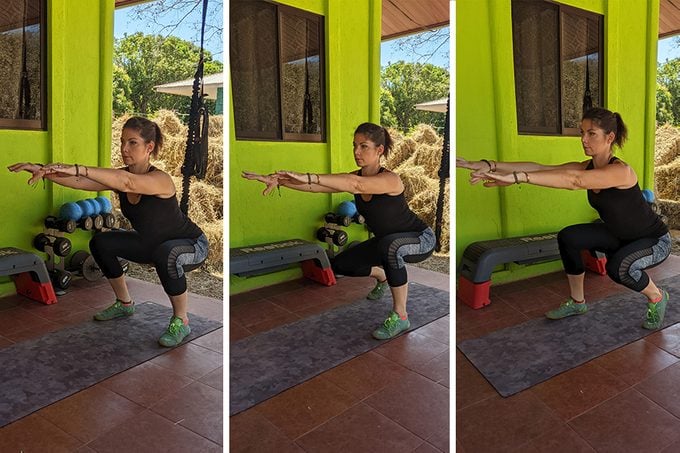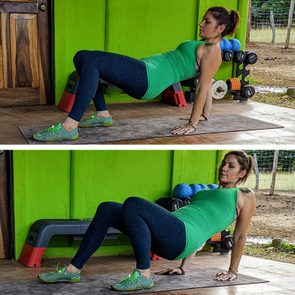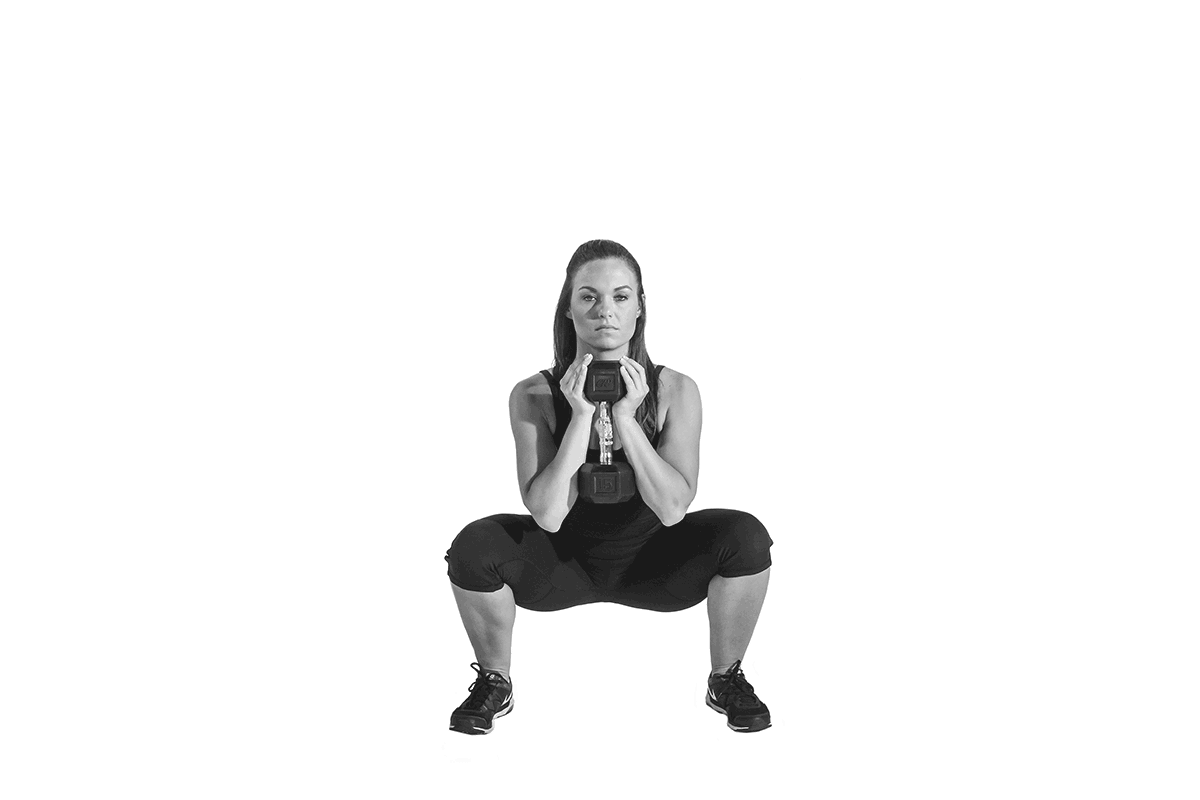Do the Duck Walk—Here’s How to Add This Exercise to Your Workout
Updated: Mar. 31, 2021
Develop strength and flexibility from performing a deep squat by adding a duck walk to your workout routine. Here's how to do it correctly.
What is the duck walk?
The first time you see someone waddling around the gym performing a duck walk, you may be tempted to snicker or pull out your phone to snap a covert video for your social media feed. But before you knock the odd-looking deep squat walk as “another dumb fitness trend,” take note: Duck walk exercise is actually a great option for those looking to work on their squat form, develop lower body strength and flexibility, and even get a little cardio in, too.
(Try the crab walk exercise for a full-body workout.)
“Duck walks are a very novel way of training all physiological aspects that transfer over to a squat,” says CJ McFarland, head strength and conditioning coach for Onnit Gym in Austin. “Doing these allows you to really focus on hip and ankle mobility, which are crucial to a good squat pattern. They also focus on creating maximal hamstring lengthening as you’re in an eccentric contraction for the entire duration of the move,” he says.
The thing is, getting into an “ass to grass” squat position is challenging for a lot of people, especially when moving from a standing position into the deep squat, and back again. This, as McFarland points out, requires flexibility at the hips, knees, and ankles, good posture and core strength, and strength in all the major muscle groups of the lower body. (These are the squat exercises you need in your life.)
Duck walk exercise basically requires you to start in this deep squat position. However, it gives you the opportunity to develop good posture and form at the lowest part of the squat, without having to move between the standing and squatting positions multiple times.
Yes—duck walk exercise is eccentric
Okay, duck walking does look odd, but it’s also eccentric in a muscular sense: During most traditional strength training exercises, there’s a concentric and eccentric contraction. When performing a squat, the eccentric contraction is the downward phase of the squat—when your quadriceps shorten and your hamstrings lengthen to accommodate and control the downward motion. Think about it—if you were to just “drop” into a squat without control, you’d likely end up injured. And actually, the ability to control this downward phase (particularly with added resistance) can help improve overall strength for the concentric (upward movement) as well.
In a 2017 study published in the Journal of Strength and Conditioning Research, people were given an “overload” of resistance (a percentage greater than their one-rep max) to control during a three-second eccentric phase of a squat, followed by a rapid concentric contraction to return to standing. Here, they experienced improvements in concentric speed and power as compared to those who didn’t use this controlled, overloaded eccentric contraction.
Likewise, a second study published in the same journal in 2017 found that eccentric squat contractions of four and six seconds (in other words, very slowly moving through the downward phase of the squat) “can be an effective method to acutely increase maximal strength and power expression.”
The thing about duck walk exercise is that it requires you to perform an eccentric squat, moving into the deepest part of the squat position. You have to assume this position and then proceed to maintain it as you “waddle” around the gym (or wherever you’re working out). Developing strength and joint flexibility in this deep position can help prepare you to more easily and readily perform a full squat with time and practice.
(Learn more about the science of eccentric contractions with this weight lifting trick to get stronger faster.)
Is the duck walk strength or cardio exercise?
Like other similar exercises, including bear crawls, crab walks, and even lunges, the duck walk can function as a strength move or a cardiovascular move, depending on how you incorporate it into your workout.
“Duck walks allow you the option to elicit any physiological response needed for your goal,” says McFarland. “To make this more of a cardiovascular exercise, simply perform this movement for a longer duration, for instance, 30 yards. To make this movement more of a strength-focused exercise, add a Bulgarian bag or front-racked kettlebells and keep the sets at a much shorter length, such as five to 10 yards.”
(Try these home-based cardio workouts.)
How to maintain good posture during the duck walk
The trick to the duck walk is to perform the exercise in the deepest part of a squat while maintaining good posture. To do this, you should engage your core and keep your shoulders back and your chest lifted. Reset and try again if you find yourself tipping forward from the hips or if you notice your shoulders rolling forward.
It’s also important to remember to perform the exercise in your deepest squat position. This may not be the same as someone else depending on differences in hip, knee, and ankle flexibility. If you find it challenging to get very low, work at the point where you can maintain good form, and gradually work on getting deeper into the duck walk over time.

How to do to the duck walk
Start standing with your feet roughly hip-distance apart, your toes angled slightly outward. Engage your core, roll your shoulders back, squeezing your scapula in toward your spine, and look straight ahead, your arms at your sides. Press your hips back and begin lowering your glutes toward the ground behind your ankles, bending your knees to accommodate the downward squat, keeping your chest lifted and shoulders back.
Make sure your knees are aligned with your toes (not collapsing inward). As you squat down, allow your arms to lift forward in front of your body to help remind you to keep your torso from collapsing forward.
(Do you have knee pain when squatting? Learn why.)
When you’re in your deepest comfortable squat, maintain this position and begin taking steps forward, more or less “waddling” like a duck. One thing McFarland warns against is allowing your butt to “oscillate up and down” as you walk; rather, you want to keep the deep squat as steady as possible as you walk forward. When you’ve completed the walk for your predetermined distance or time, set yourself in the deep squat position (your feet once again aligned, not staggered), then press through your heels and extend your knees and hips to return to standing.
When you should skip the duck walk
While duck walks can be an excellent way for someone who struggles with deep squats to develop eccentric strength, flexibility, and control to improve the squat, the exercise won’t be comfortable for everyone. McFarland says that if you have chronic pain in your ankles, knees, or hips, you should ease yourself into the movement or skip it altogether. “This exercise can cause a lot of mechanical stress in those areas and you don’t want to aggravate them even more,” he says.
(This is the best workout for every age.)
Try a wall squat first
One way to work yourself up to duck walks, or to work on strength in a deep squat in a less mechanically stressful manner, is to start with a wall squat, says McFarland. Not unlike a duck walk, a wall squat requires you to hold a squat position in an eccentric phase of the squat movement. But the wall provides additional support, and it doesn’t require you to achieve a full, “ass to grass” position with your glutes positioned lower than your knees.
“Once you’ve developed confidence with wall sits, you can try adding duck walks to your workout,” McFarland says. (These are the best butt workouts besides squats.)
Adding a duck walk to your strength workout
McFarland likes adding duck walks to the end of a strength training routine as a “finisher.” In other words, you’ve already performed the bulk of your routine, and these are added as a short way of “burning out” your muscles as a final challenge. When strength training, try adding three to five sets of duck walks performed for five to 10 yards while carrying extra resistance. For instance, you can hold a dumbbell in front of your chest in a goblet-squat position, or you can use a barbell across the back of your shoulders in a back squat position.
(What you should know about starting a strength training routine.)
Adding a duck walk to your circuit workout
Duck walks are a great option for fitting in cardio between strength exercises if you’re performing a full-body circuit routine. You’re able to reap both strength training and cardio benefits in a single workout.
In cases like this, between each strength exercise, perform an unloaded duck walk for 20 to 60 seconds. Or, alternate between performing a duck walk and another cardio-focused move, like jumping jacks, between strength moves. An example workout might look something like:
-
40 seconds walking lunges
-
20 seconds jumping jacks
-
40 seconds pushups
-
20 seconds duck walks
-
40 seconds deadlifts
-
20 seconds jumping jacks
-
40 seconds renegade rows
-
20 seconds duck walks
-
40 seconds plank holds
-
20 seconds jumping jacks
-
1-2 minutes rest
Repeat the circuit four to five times for a 20 to 30-minute routine, depending on how much rest you give yourself between circuits.
(Try this 15-minute strength training routine that works the whole body.)
Duck walk variations
Duck walks can be mixed up based on arm position. For instance, you can extend your arms in front of you, cross your arms in front of your shoulders, extend your arms overhead, or place your hands behind your ears for added resistance. The sky is practically the limit with duck walks, as you can utilize kettlebells, dumbbells, a medicine ball, barbell, or sandbag to add resistance. But regardless, start with a basic, unweighted duck walk and master proper form before you get fancy with variations.













